Overview
This article delineates ten significant advantages of brushless radiator fan technology for engineers, highlighting their superior efficiency, extended lifespan, and cost-effectiveness in comparison to traditional fans. It substantiates these assertions by elaborating on how brushless fans enhance cooling performance, minimize energy consumption, and necessitate reduced maintenance. These characteristics position brushless fans as an optimal choice for a wide array of engineering applications.
Introduction
Brushless radiator fans are transforming the thermal management landscape in engineering, delivering not only enhanced efficiency but also substantial cost savings. As industries increasingly focus on sustainability and performance, these advanced cooling solutions have become essential for engineers aiming to optimize their designs. Yet, with a multitude of options available, what distinguishes brushless technology from traditional alternatives? By examining the ten key benefits of brushless radiator fan technology, we uncover how these innovations can revolutionize cooling systems and elevate overall performance across diverse applications.
Gagner-Toomey Associates: Leading Provider of Brushless Cooling Solutions
Gagner-Toomey Associates stands at the forefront of the electronics sector, specializing in advanced thermal management solutions, particularly with brushless radiator fans. With a diverse portfolio of exceptional manufacturers, Gagner-Toomey is committed to to address intricate challenges in cooling, power management, and beyond.
The global market for brushless DC motors was valued at USD 16.41 billion in 2023 and is projected to reach USD 26.01 billion by 2030, reflecting a compound annual growth rate of 6.8% from 2025 to 2030. This growth trajectory is fueled by the rising demand for energy-efficient solutions, positioning brushless radiator fans as the optimal choice for a variety of engineering applications.
Their productivity, reduced noise levels, and compact design have rendered them particularly favored in sectors such as automotive, which accounted for approximately 35% of the overall market in 2023, as well as in consumer electronics.
Industry leaders emphasize that the integration of advanced technologies in fanless thermal management solutions not only enhances operational efficiency but also aligns with the growing demand for sustainable practices. Innovations in technology related to brushless radiator fans are on the horizon, with 2025 expected to showcase advancements such as smart controls and IoT integration, further elevating performance.
Gagner-Toomey Associates, through its unwavering commitment to excellence, ensures that clients access innovative products that effectively address complex issues in temperature control and power management, empowering them to leverage the latest advancements in their projects.

Enhanced Cooling Efficiency: The Key Advantage of Brushless Radiator Fans
Brushless radiator fans are engineered to provide significantly enhanced temperature regulation compared to conventional models. By utilizing advanced motor technology, these devices dynamically adjust their speed in response to real-time temperature management needs, thereby optimizing both airflow and thermal regulation. This adaptability not only improves the performance of cooling systems but also of engine components by effectively preventing overheating.
For instance, motorized cooling devices can achieve energy conversion rates exceeding 90%, while traditional DC motors typically operate at 85-90% efficiency, underscoring the superior performance of brushless systems in comparison to conventional cooling solutions. Engineers have noted that electronic commutation in motorized devices minimizes heat production, whereas standard models generate more noise and heat due to friction from brushes, further enhancing their longevity and reliability.
In practical applications, such as automotive temperature regulation systems, the use of a brushless radiator fan has led to notable improvements in engine performance and fuel efficiency. Furthermore, the adoption of BLDC devices is increasingly prevalent in residential and commercial settings due to their energy efficiency, showcasing the tangible benefits of embracing this advanced motor technology in cooling applications.

Increased Longevity: How Brushless Fans Outlast Traditional Options
Brushless radiator fans stand out due to their remarkable durability, often exceeding 50,000 hours of operation. Notably, the MDE Series axial flow DC motors boast an impressive life expectancy of up to 100,000 hours. Unlike traditional models that depend on brushes—elements susceptible to wear—brushless radiator fans utilize electronic commutation. This innovative approach markedly diminishes mechanical degradation, leading to .
For instance, SPAL’s silent motors are engineered to last four to five times longer than their conventional counterparts, achieving lifespans nearing 40,000 hours, compared to the typical 5,000 to 15,000 hours of non-silent alternatives. Furthermore, SPAL’s non-brushed motors are priced between $450 and $500 for individual units, with complete systems available for approximately $700.
This extended lifespan of the brushless radiator fan not only enhances reliability but also yields significant cost savings for engineers, positioning it as a highly economical choice over time. As Ryan Salata, Marketing Director at PROFORM, articulates, “Electric ventilators can sustain steady performance without drawing energy from the engine, thereby improving overall vehicle efficiency and fuel economy.” The diminished need for maintenance further solidifies their status as a superior alternative within the electronics sector.
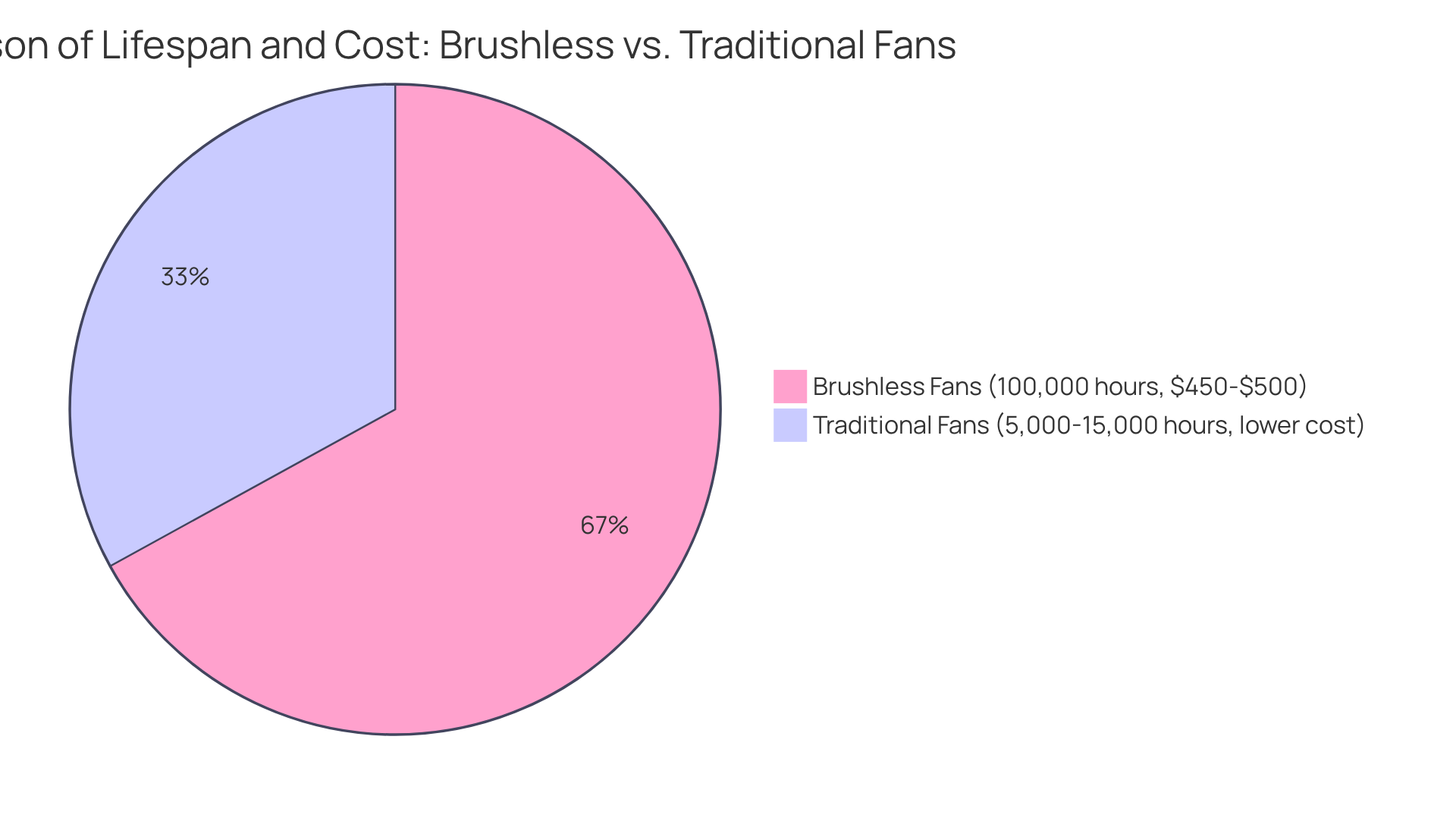
Energy Efficiency: Lower Fuel Consumption with Brushless Technology
Brushless radiator fans are designed with energy conservation as a primary focus, utilizing significantly less power than their brushed counterparts. This reduction in energy consumption not only decreases operational costs but also enhances in vehicles. By minimizing the electrical demand on the engine, systems using a brushless radiator fan contribute to improved overall vehicle performance while supporting sustainability initiatives.
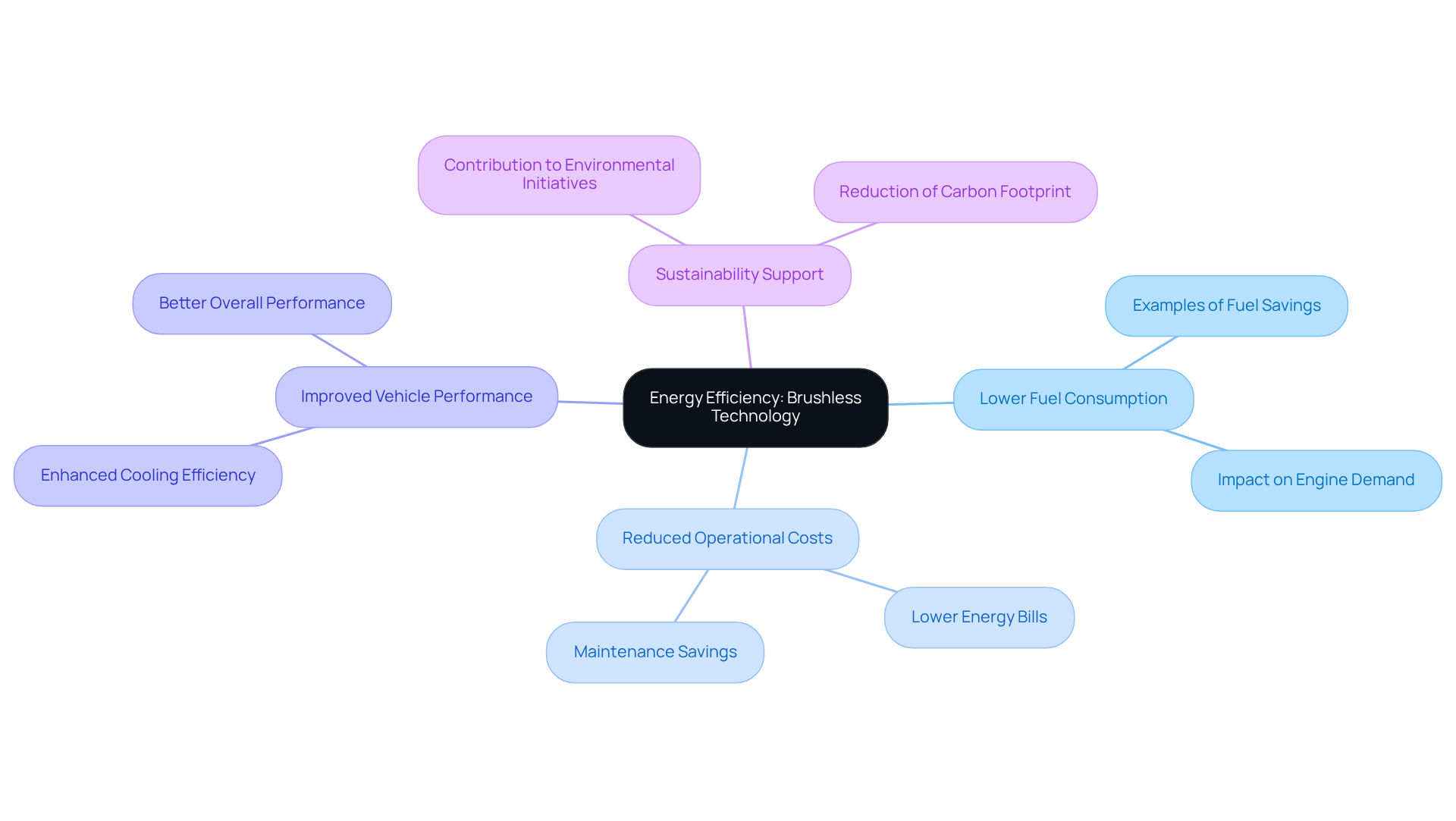
Noise Reduction: Enjoy a Quieter Ride with Brushless Radiator Fans
One of the standout benefits of motorized radiator units is their remarkable silent performance. By eliminating brushes, these devices significantly decrease friction, resulting in reduced noise levels during operation. This characteristic is especially advantageous in environments where is paramount, such as luxury vehicles and electric cars.
For instance, vehicles equipped with silent cooling systems can achieve noise reductions of up to 60%, leading to a serene driving experience that enhances user comfort. Automotive designers stress that minimizing noise is essential for meeting consumer expectations for a high-tech, tranquil ride.
According to the National Renewable Energy Laboratory, reducing noise and vibration ranks among the top priorities for EV manufacturers, particularly as drivers anticipate a peaceful, high-tech experience in their new vehicles. As the demand for quieter automobiles escalates, the integration of brushless fan technology becomes increasingly crucial in delivering a premium driving experience.
Furthermore, the quieter operation of these devices contributes to decreased energy consumption and a reduced carbon footprint, aligning with the sustainability goals of modern engineering practices.
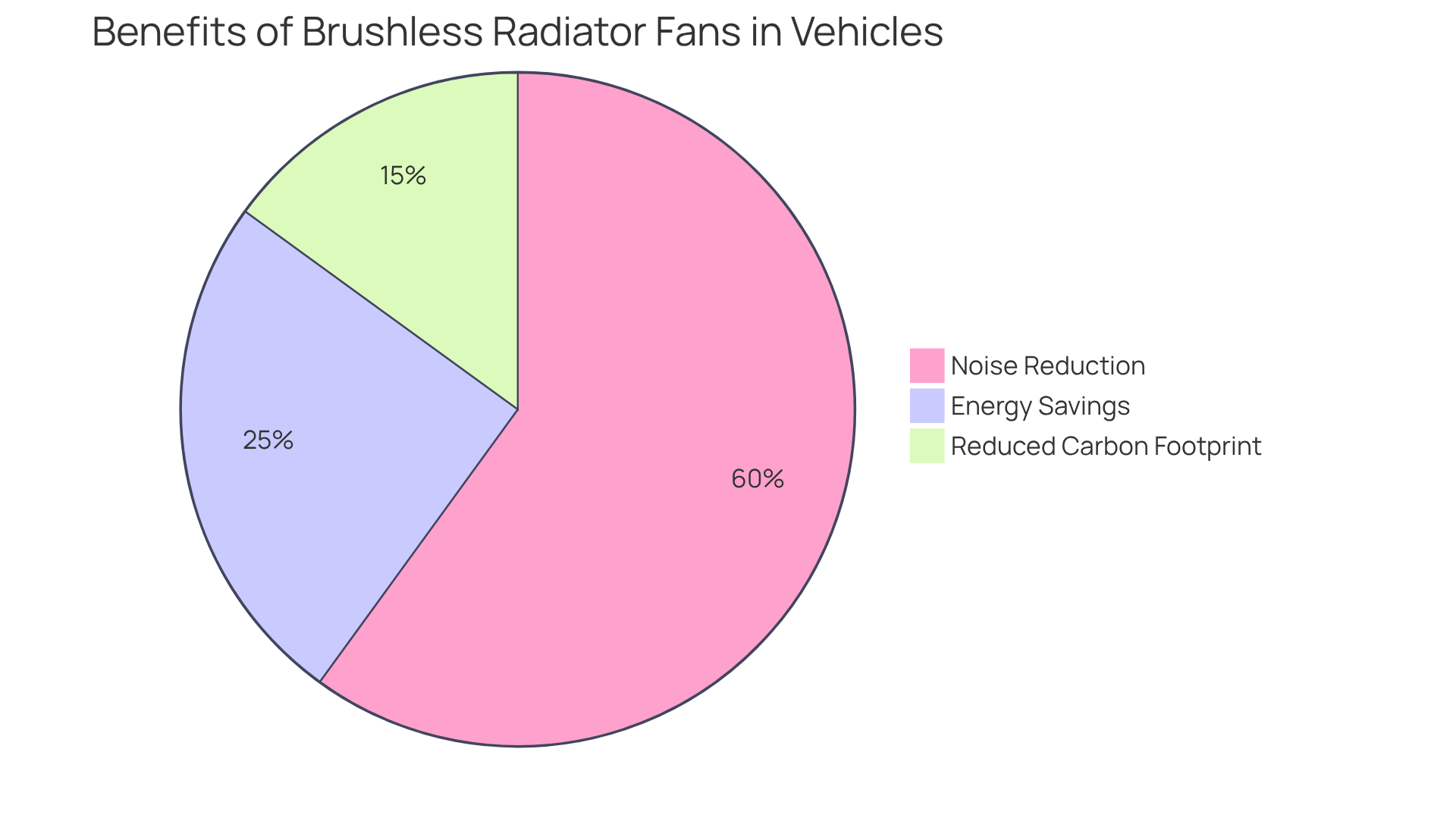
Versatility: Brushless Radiator Fans for All Vehicle Types
Brushless radiator fans represent highly adaptable solutions tailored for a wide range of vehicle types, from passenger cars to heavy-duty trucks. Their compact design and customizable features empower engineers to seamlessly integrate them into various temperature control systems. This flexibility not only supports innovative designs but also facilitates the retrofitting of existing systems, thereby ensuring optimal performance across multiple applications.
For instance, the adoption of non-brushed cooling devices in heavy-duty trucks has surged, driven by their proven effectiveness and durability. Some models are engineered to last up to 40,000 hours, significantly outpacing conventional models that typically endure only between 5,000 to 15,000 hours. This remarkable longevity, coupled with the ability to customize setups to meet specific vehicle requirements, positions the brushless radiator fan motors as a preferred choice for engineers aiming to and improve system dependability.
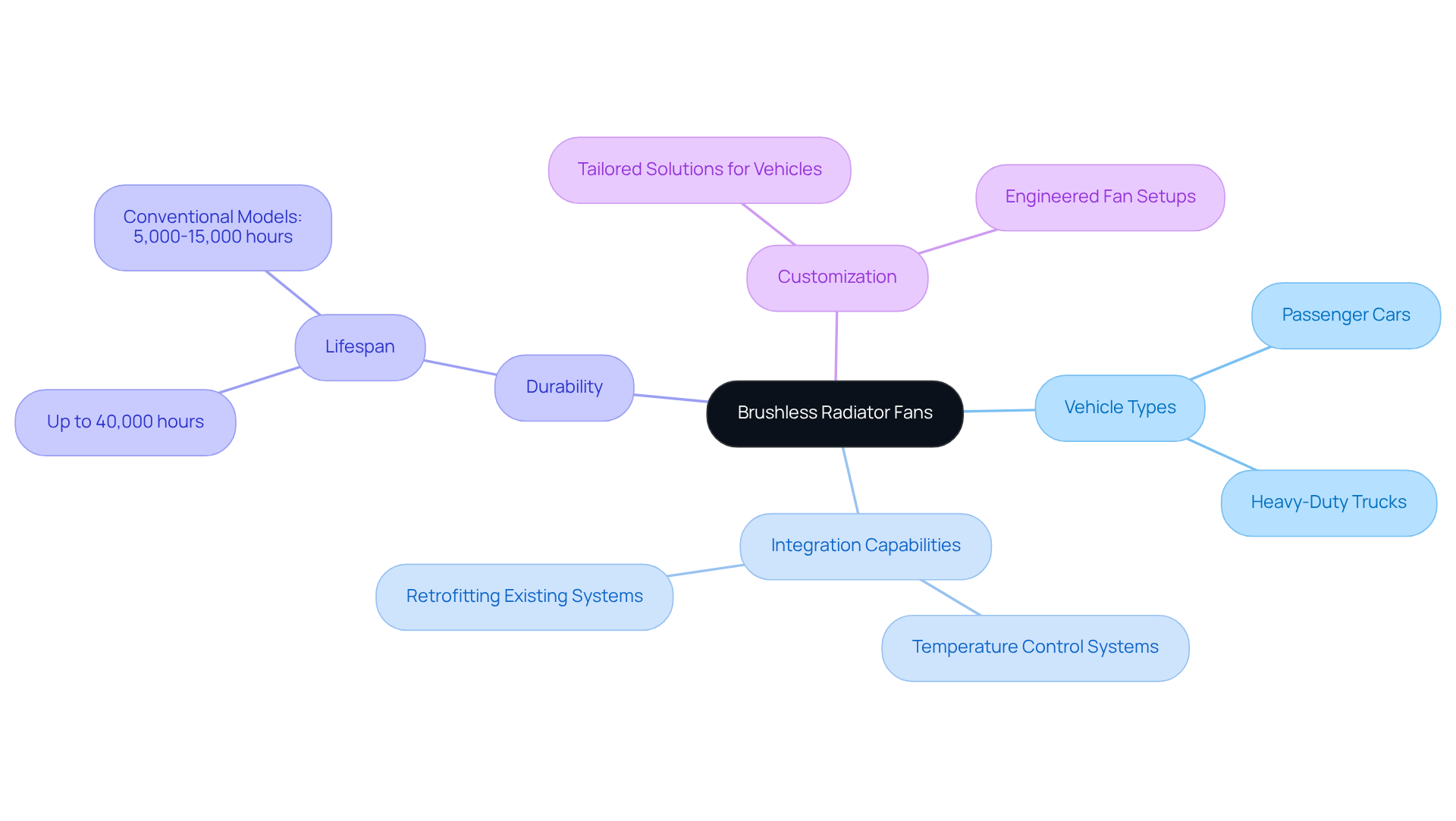
User-Friendly Installation: Simplifying the Upgrade to Brushless Fans
Upgrading to a presents a streamlined process that significantly reduces installation time and complexity. Many models are equipped with universal mounting options and straightforward installation instructions, enabling technicians to retrofit them into existing systems with remarkable ease. This user-friendly approach not only minimizes labor costs but also empowers engineers to swiftly adopt these advanced cooling solutions without the necessity for extensive modifications. Technicians have noted that the incorporation of motor technology enhances overall system efficiency, making it a preferred choice in engineering projects.
Moreover, transitioning to bladeless units can yield substantial savings, with an estimated yearly electricity expense reduction of ₹1,226,400. Furthermore, these devices have the potential to decrease CO2 emissions by up to 41.13 tons annually, contributing to a more sustainable environment. The durability of Gagner-Toomey’s motorized devices, often exceeding 50,000 hours, further solidifies their reliability and cost-efficiency.
Integrating insights from engineers, one remarked, “The simplicity of installation with advanced motors has transformed our approach to upgrading temperature regulation systems, allowing us to focus on enhancing performance rather than contending with complicated arrangements.” This ease of installation leads to significant reductions in labor expenses, further reinforcing the case for transitioning to a brushless radiator fan.
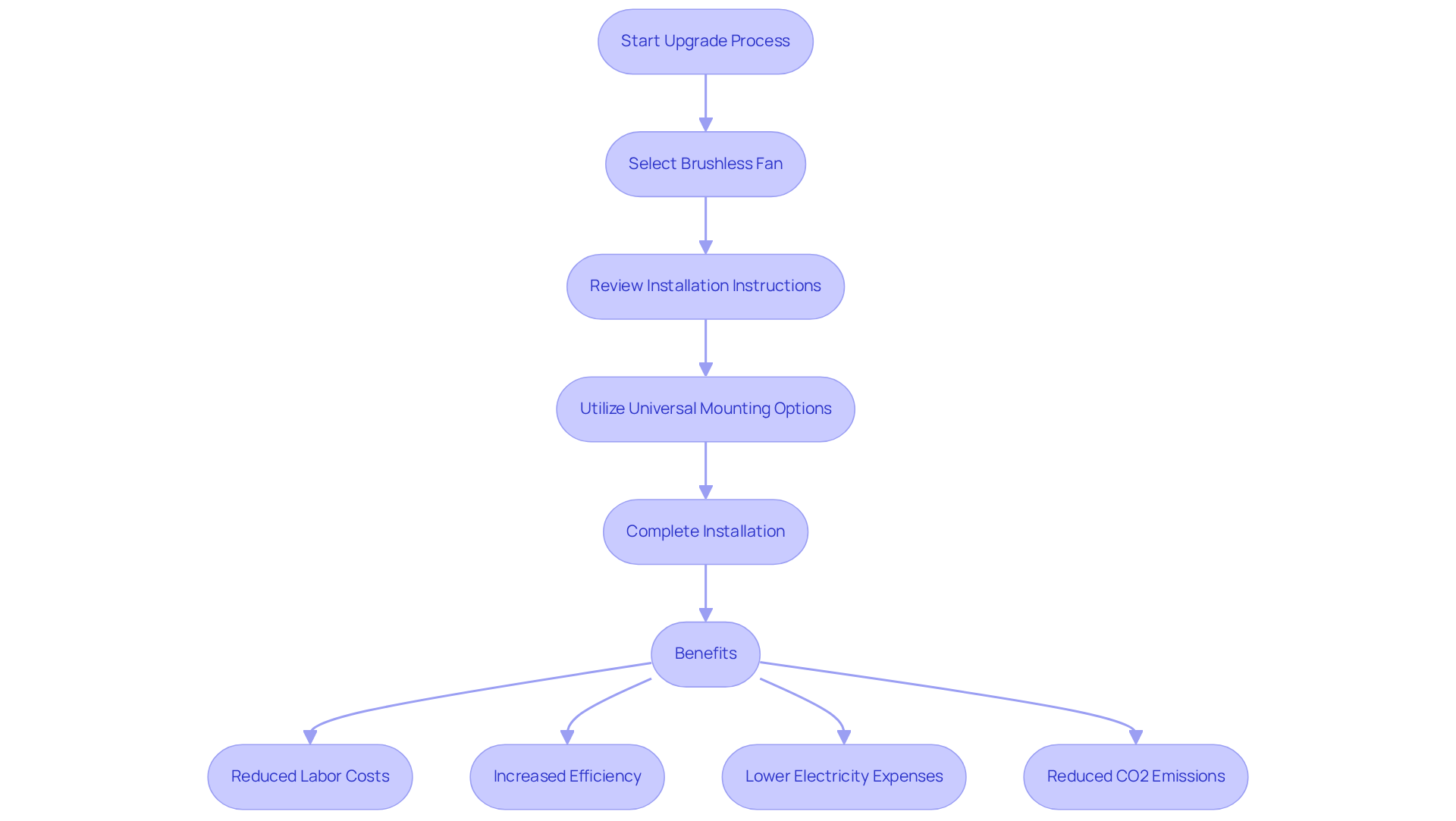
Performance Boost: Optimizing Cooling Systems with Brushless Fans
Brushless radiator fans significantly elevate cooling system performance by delivering consistent airflow tailored to the engine’s specific cooling requirements. By adjusting their speed based on temperature readings, the brushless radiator fan plays a crucial role in maintaining optimal engine temperatures, effectively preventing overheating and boosting overall efficiency. This feature is particularly beneficial in high-demand situations, such as racing or heavy towing, where is paramount.
Statistics indicate that instances of overheating in engines equipped with non-brushed cooling systems are markedly reduced, underscoring their effectiveness in preserving engine integrity under stress.
Automotive engineers assert that the integration of advanced technology, including the brushless radiator fan, not only optimizes cooling systems but also extends the lifespan and reliability of engine components, establishing them as an indispensable choice for contemporary automotive applications.
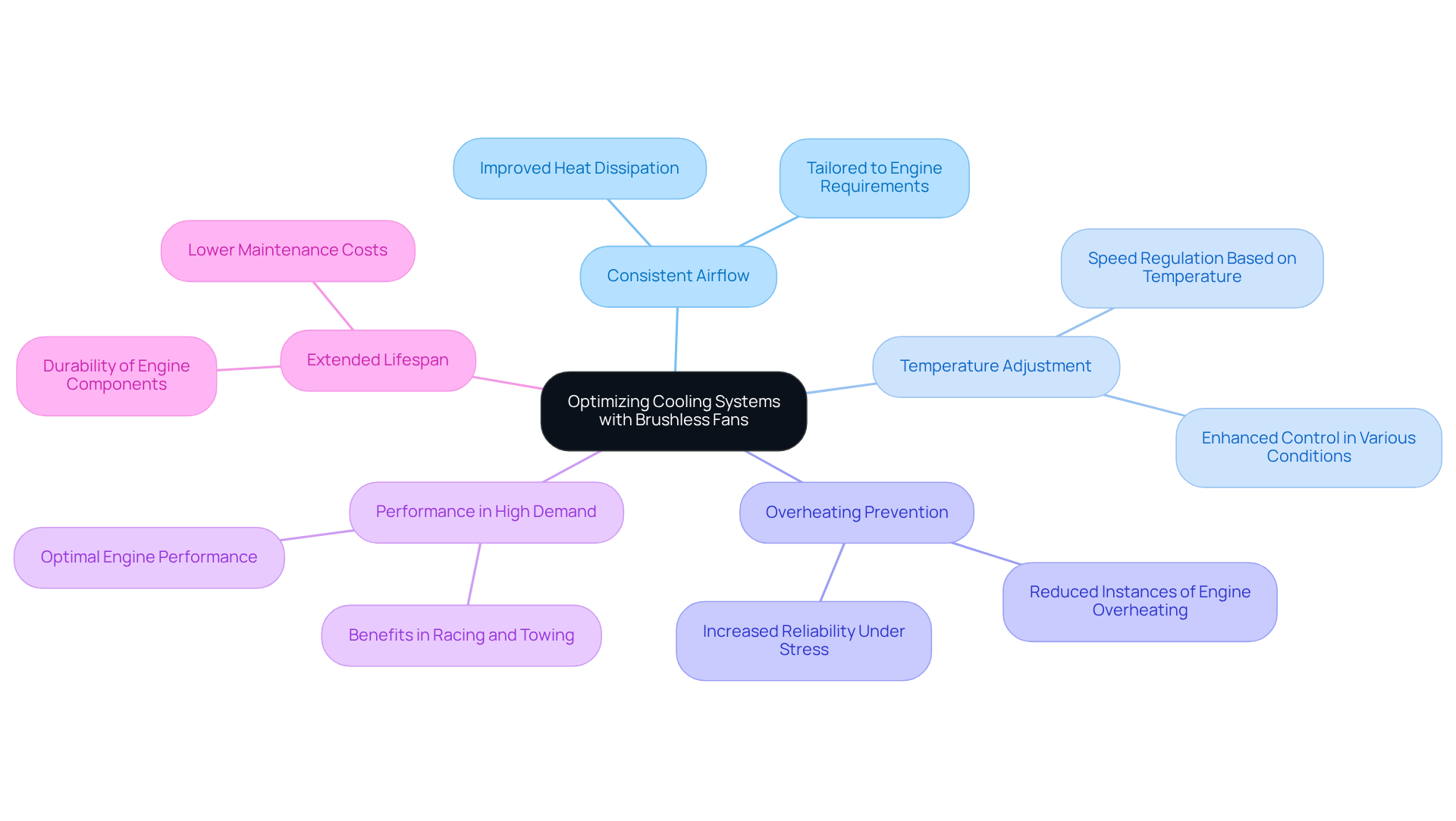
Cost-Effectiveness: Save Money with Brushless Radiator Fans
Investing in radiator cooling devices is a financially astute decision that offers substantial long-term benefits. While the initial investment may exceed that of traditional models, the remarkable savings on energy consumption—up to 60% less electricity—quickly offset this cost.
For instance, switching to a brushless radiator fan can yield annual savings of approximately ₹1,226,400, as evidenced by a comparison of yearly electricity costs:
- ₹2,299,500 for conventional models
- ₹1,073,100 for BLDC motors
Furthermore, these devices require minimal maintenance due to their robust construction and fewer moving parts, leading to reduced replacement costs and minimized downtime. The durability of motorless units often surpasses that of traditional designs, enhancing operational efficiency and making them an ideal choice for engineers aiming to optimize their budgets while ensuring reliable performance.
With advanced features such as for precise airflow control, brushless radiator fans represent a cutting-edge solution in the engineering sector.
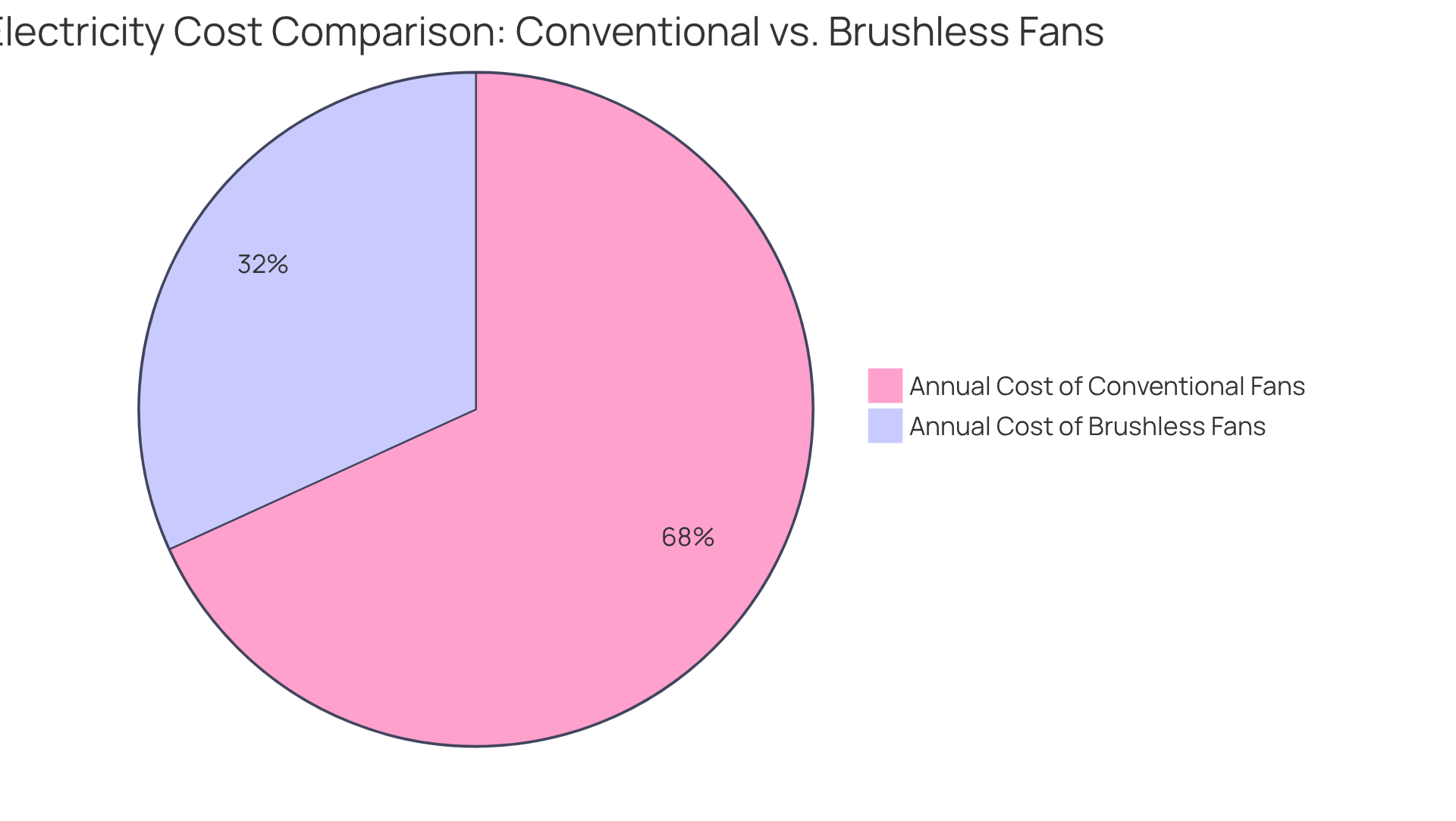
Technological Advancements: The Future of Brushless Radiator Fan Design
The future of non-brushed radiator fan design is on the brink of substantial transformation, driven by continuous technological advancements that enhance effectiveness and performance. Key innovations are emerging, such as:
- Smart control systems that optimize fan operation based on real-time conditions
- Advanced materials that improve durability and thermal management
- Refined motor designs that boost energy efficiency
As engineers strive to meet stringent performance criteria, these brushless radiator fans are set to become essential components in the evolution of temperature regulation technology. Furthermore, the integration of IoT features is anticipated to enhance functionality, facilitating improved monitoring and control of refrigeration systems.
With the brushless radiator fan market valued at USD 2.5 billion in 2024 and by 2033, the sector is not merely responding to current demands; it is also laying the groundwork for future innovations that will redefine cooling solutions across various applications. As industry leader Phil Mortimer emphasizes, ‘This technology is crucial for addressing the energy efficiency challenges faced by modern data centers, which struggle with high energy consumption and heat dissipation.

Conclusion
Brushless radiator fan technology emerges as a transformative solution for engineers aiming to enhance cooling efficiency across diverse applications. By leveraging advanced motor designs and energy-efficient features, these fans not only optimize temperature regulation but also extend the lifespan of engine components. This makes them an invaluable asset in contemporary engineering practices.
The article underscores several key advantages of brushless radiator fans:
- Superior energy efficiency
- Reduced noise levels
- Remarkable durability
- User-friendly installation
Collectively, these benefits contribute to significant cost savings and improved performance, positioning brushless fans as the preferred choice over traditional models in sectors such as automotive and consumer electronics.
As the demand for sustainable and efficient cooling solutions escalates, the adoption of brushless radiator fans is poised for growth. Engineers are encouraged to explore the potential of this technology, not only to meet current performance standards but also to innovate for future advancements. Embracing these cutting-edge solutions will enhance operational efficiency and align with broader environmental goals, ultimately paving the way for a more sustainable engineering landscape.
Frequently Asked Questions
What does Gagner-Toomey Associates specialize in?
Gagner-Toomey Associates specializes in advanced thermal management solutions, particularly focusing on brushless radiator fans for the electronics sector.
What is the current market value of brushless DC motors and its projected growth?
The global market for brushless DC motors was valued at USD 16.41 billion in 2023 and is projected to reach USD 26.01 billion by 2030, reflecting a compound annual growth rate of 6.8% from 2025 to 2030.
Why are brushless radiator fans preferred in various sectors?
Brushless radiator fans are preferred due to their productivity, reduced noise levels, and compact design, making them particularly favored in sectors such as automotive and consumer electronics.
How do brushless radiator fans enhance cooling efficiency?
Brushless radiator fans provide enhanced temperature regulation by dynamically adjusting their speed based on real-time temperature management needs, optimizing airflow and thermal regulation, which improves cooling system performance and extends engine component lifespan.
What is the efficiency comparison between brushless and traditional DC motors?
Brushless radiator fans can achieve energy conversion rates exceeding 90%, while traditional DC motors typically operate at 85-90% efficiency, highlighting the superior performance of brushless systems.
What is the lifespan of brushless radiator fans compared to traditional models?
Brushless radiator fans often exceed 50,000 hours of operation, with some models like the MDE Series axial flow DC motors lasting up to 100,000 hours, compared to traditional models that last between 5,000 to 15,000 hours.
What are the cost implications of using brushless radiator fans?
The extended lifespan and reduced maintenance needs of brushless radiator fans lead to significant cost savings over time, making them a highly economical choice for engineers.
What advancements are expected in brushless radiator fan technology by 2025?
By 2025, advancements such as smart controls and IoT integration are expected to enhance the performance of brushless radiator fans further.
How do brushless fans contribute to vehicle efficiency?
Brushless fans can sustain steady performance without drawing energy from the engine, improving overall vehicle efficiency and fuel economy.

